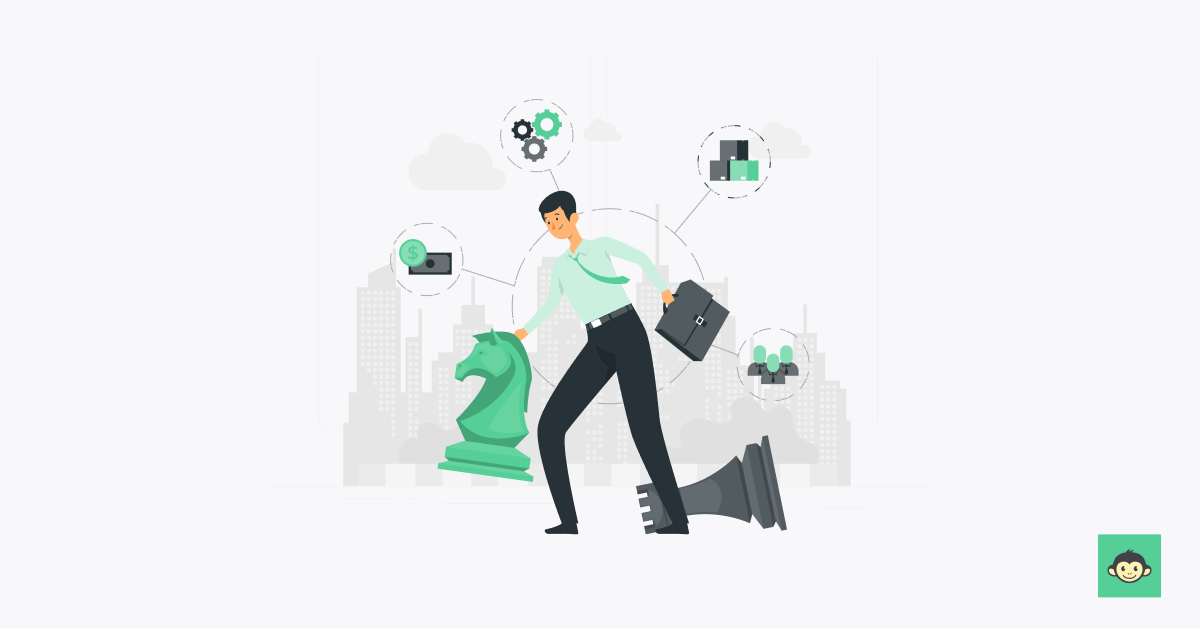13 Employee engagement challenges to solve in 2024

As we venture into the dynamic landscape of 2024, the spotlight on employee engagement is brighter than ever.
Beyond its trendy facade, employee engagement is the cornerstone of a thriving workplace, weaving a tapestry of productivity and job satisfaction. Before we unravel the 13 challenges awaiting our attention, let's begin by deciphering the two pivotal types of employee engagement that form the nucleus of organizational dynamics.
So, fasten your seatbelts as we embark on this insightful journey to unlock the secrets of a harmonious and high-performing workplace!
What are the two types of employee engagement?

There are two distinct types that shape the employee experience – Transactional Engagement and Emotional Engagement.
1. Transactional engagement
Think of this as surface-level involvement. Employees are here for the job – a fair day's work for a fair day's pay. It's the basic contractual agreement where tasks are completed, but the emotional connection might be lacking.
Picture a cashier swiftly processing transactions but not necessarily emotionally invested in the customer experience.
2. Emotional engagement
Now, this is where the magic happens. Emotional engagement transcends the transactional. It's about forging a genuine connection with the work, colleagues, and the overall mission of the organization.
Employees aren't just ticking off tasks; they're actively invested in the success of the company. Imagine a team member who not only meets targets but also actively contributes ideas and energy to enhance the team's synergy.
Understanding these two types lays the foundation for addressing the intricate challenges that may arise on the engagement front.
Let's dive deeper into the nuances to ensure a workplace where both transactional and emotional engagement thrive harmoniously.
Employee engagement challenges best practices

Now that we've decoded the dual nature of employee engagement, let's explore the proactive strategies that form the bedrock of a flourishing workplace.
Beyond mere awareness, adopting best practices ensures that you're not just managing challenges but proactively nurturing a culture of sustained engagement.
Tailor recognition programs
Challenge: One-size-fits-all recognition programs often miss the mark, leaving some employees feeling undervalued.
Best practice: Customize recognition efforts to align with individual preferences. Whether it's a public shout-out or a private acknowledgment, personalization fosters a sense of genuine appreciation.
Foster inclusive communication
Challenge: Communication breakdowns can create disengagement, especially in large or remote teams.
Best practice: Prioritize transparent and inclusive communication. Leverage various channels and formats to cater to diverse preferences. Regular check-ins, town hall meetings, and collaborative platforms bridge the communication gap.
Continuous learning opportunities
Challenge: Stagnation breeds employee disengagement. When employees feel their growth is stunted, motivation takes a hit.
Best practice: Embed continuous learning into the company culture. Offer diverse training opportunities, mentorship programs, and skill development initiatives to empower employees on their professional journey.
Embrace flexibility
Challenge: Rigidity in work structures can also hinder employee engagement and engagement, particularly in an era where work-life balance is a top priority.
Best practice: Embrace flexibility in work arrangements. Whether it's remote work options, flexible schedules, or compressed workweeks, providing autonomy contributes to a more engaged and satisfied workforce.
By intertwining these best practices with your organizational DNA, you're not just tackling challenges – you're fostering an environment where engagement becomes second nature. Let's now pivot to understanding the four pillars that uphold the architecture of a truly engaged workforce.
What are the 4 pillars of employee engagement?

In the grand tapestry of employee engagement, four robust pillars stand tall, shaping the very essence of a thriving workplace.
Let's delve into each pillar, understanding how they collectively fortify the foundation of a workforce that's not just present but passionately engaged.
1. Meaningful work
At the core of engagement lies the significance of the work itself. When employees find purpose and meaning in their tasks, it transcends the mundane. Providing clarity on how individual contributions align with team members and broader organizational goals creates a sense of fulfillment, turning jobs into meaningful journeys.
2. Supportive leadership
Leadership isn't just about steering the ship; it's about inspiring the crew. Supportive leaders cultivate an environment where employees feel heard, valued, and encouraged.
This pillar emphasizes the role of leaders in shaping the workplace culture, setting the tone for open communication, and fostering a sense of belonging.
3, Positive work environment
Picture a workplace where positivity permeates the air. A positive work environment is more than just bean bags and colorful walls; it's about cultivating a culture where collaboration thrives, innovation is celebrated, and employees feel psychologically safe. When the workplace becomes a source of inspiration, engagement follows suit.
4. Growth opportunities
Engagement thrives in an environment that nurtures professional and personal growth. This pillar underscores the importance of providing avenues for skill development, career progression, and continuous learning.
Employees are more engaged when they see a future within the organization, with opportunities to expand their skills and climb the professional ladder.
By reinforcing these four pillars, you're not just addressing the surface-level symptoms of disengagement; you're fortifying the very structure that sustains a vibrant and motivated workforce.
Now, let's pivot to why measuring employee motivation and engagement is not just a practice but a strategic imperative.
Why should you measure employee engagement?

In the intricate dance of workplace dynamics, measurement isn't about mere numbers; it's about gaining insights that fuel strategic decisions and foster a thriving work culture. Here's why keeping a pulse on employee engagement isn't just a good idea but a strategic imperative.
Diagnostic insights
Measuring engagement serves as a diagnostic tool, offering insights into the health of your organization. It goes beyond surface-level observations, helping you pinpoint areas of strength and areas that may need attention. Think of it as an X-ray for your organizational well-being.
Proactive issue resolution
Engagement metrics act as early warning signals. By identifying trends and patterns, you can address potential issues before they escalate. Whether it's a dip in morale, poor communication, breakdowns, or evolving expectations, measurement provides a proactive lens for issue resolution.
Tailored interventions
One size doesn't fit all when it comes to employee engagement strategies. Measurement allows you to tailor interventions based on specific needs and challenges within your organization. It's about precision, ensuring that your efforts align with the unique pulse of your workforce.
Impact on business outcomes
Engagement isn't a feel-good metric; it directly influences key business outcomes too. Research consistently shows a strong correlation between engaged employees and increased productivity, customer satisfaction, and overall organizational success.
Demonstrating value
Leadership and stakeholders often seek tangible evidence of the impact of engagement initiatives. Measurement provides the data needed to showcase the value of your efforts.
It's about translating intangible concepts into quantifiable results, reinforcing the importance of a vibrant workplace and positive company culture.
In essence, measuring employee engagement is a strategic compass guiding your organization toward a future where employee well-being isn't just a checkbox but a driving force behind sustained business success. Now, let's unravel the intricacies of how to measure employee engagement effectively.
How do we measure employee engagement?

Measuring and improving employee engagement isn't a one-size-fits-all endeavor; it's a nuanced process that demands thoughtful consideration. Here's a curated guide on navigating the intricacies of gauging employee engagement effectively.
Employee surveys with the purpose
Craft surveys with specific goals in mind. Don't just collect data for the sake of it; ask questions that unveil insights into aspects like job satisfaction, team dynamics, and alignment with organizational values. Keep it concise to encourage honest and focused responses.
Utilize Key Performance Indicators (KPIs)
Beyond surveys, leverage KPIs that reflect engagement levels. Look at absenteeism rates, turnover numbers, and productivity metrics. An increase in absenteeism or a sudden spike in turnover could be indicative of underlying employee engagement problems or issues.
Social listening and feedback platforms
Tap into the power of social listening tools and feedback platforms. Monitor internal communication channels, social media, and employee feedback platforms to gauge sentiments in real-time. This provides a dynamic, ongoing assessment of the pulse of your workforce.
Stay agile with pulse surveys
In a rapidly evolving work landscape, the annual survey might not suffice. Implement regular pulse surveys to capture real-time feedback. These shorter, more frequent check-ins provide a continuous flow of insights and enable swift adjustments to engagement strategies.
Analyze Employee Net Promoter Score (eNPS)
Much like the NPS used for customer satisfaction, the eNPS measures how likely employees are to recommend your organization as a place to work. It's a straightforward metric that reflects the overall sentiment of your workforce.
By weaving these methods into your employee engagement surveys measurement toolkit, you're not just checking a box; you're actively creating a feedback loop that informs your strategies.
Now, armed with these insights, let's turn our attention to the 13 employee engagement challenges that demand our consideration in the dynamic landscape of 2024.
13 Employee engagement challenges to keep a tab on in 2024

With a keen understanding of the hurdles that may define our employee health and engagement in 2024, it's time to roll up our sleeves and explore practical solutions.
Let's dive into actionable insights and navigate the path to sustained employee satisfaction and productivity.
1. Digital burnout
Challenge: The boundary between work and personal life is blurrier than ever, contributing to digital burnout.
Solution: Promote digital detox practices, encourage breaks, and set clear expectations regarding after-hours communication.
Introduce digital well-being initiatives, encouraging regular breaks, and implementing clear guidelines for after-hours communication. Foster a culture that values downtime and respects employees' work-life balance.
2. Hybrid work struggles
Challenge: Navigating the complexities of hybrid work models may lead to feelings of isolation and communication gaps.
Solution: Establish a robust hybrid work policy that prioritizes communication and inclusivity. Organize regular virtual team-building activities to bridge the physical gap and ensure that remote employees feel as connected as their in-office counterparts.
3. Purpose misalignment
Challenge: If employees feel disconnected from the company's mission, engagement suffers.
Solution: Conduct regular town hall meetings to reinforce the organizational mission. Encourage leaders to connect with teams, emphasizing the impact of individual contributions on the larger picture. Implement initiatives that showcase the meaningfulness of the work.
4. Well-being concerns
Challenge: Balancing work and well-being is a growing concern, impacting employee mental and physical health.
Solution: Implement mental health support programs, offer flexible schedules, and promote a stigma-free environment for discussing well-being. Foster a culture that prioritizes self-care and emphasizes the importance of both physical and mental health.
5. Recognition gaps
Challenge: Inconsistent or inadequate recognition can lead to feelings of underappreciation.
Solution: Establish a comprehensive recognition program that goes beyond monetary rewards. Encourage peer-to-peer recognition and create a culture of appreciation. Ensure that recognition efforts align with individual preferences.
6. Diversity and inclusion struggles
Challenge: Fostering an inclusive environment requires ongoing effort and can be hindered by unconscious biases.
Solution Conduct regular diversity training, review hiring processes for biases, and establish mentorship programs. Foster a culture of inclusivity where every voice is not only heard but valued.
7. Tech fatigue
Challenge: Overreliance on digital tools can contribute to tech fatigue and hinder productivity.
Solution: Streamline digital tools, provide training on efficient tool utilization, and encourage breaks from screens. Establish guidelines for the appropriate use of technology to prevent burnout and enhance productivity.
8. Leadership adaptability
Challenge: Leadership styles that don't adapt to changing dynamics can create disengagement.
Solution: Prioritize leadership development programs that focus on adaptability and emotional intelligence. Encourage a culture where leaders actively seek feedback and demonstrate a commitment to continuous learning.
9. Flexible work policy ambiguity
Challenge: Ambiguous flexible work policies can lead to uncertainty and uneven experiences among employees.
Solution: Clearly communicate flexible work policies, ensuring transparency and fairness. Establish guidelines for remote and flexible work arrangements, setting expectations for both employees and managers.
10. Communication overload
Challenge: Excessive communication can lead to information overload and decreased engagement.
Solution: Streamline communication channels, prioritize essential information, and foster a culture of concise and effective messaging. Implement communication guidelines that promote clarity and reduce information overload.
11. Career development stagnation
Challenge: Lack of clear growth paths can contribute to a sense of stagnation and disengagement.
Solution: Implement mentorship programs, provide opportunities for skill development, and offer regular feedback on performance and growth. Clearly outline career paths and create a culture that encourages continuous learning.
12. Change management fatigue
Challenge: Constant organizational changes can lead to change management fatigue among employees.
Solution: Communicate changes transparently, involve employees in decision-making processes, and provide resources for coping with change. Establish a change management strategy that prioritizes employee well-being and involvement.
13. Work-life integration
Challenge: Achieving a healthy work-life balance can be challenging, impacting overall well-being.
Solution: Encourage boundaries, promote time management skills, and lead by example in prioritizing work-life integration.
As we step into 2024, addressing these challenges head-on ensures a workplace that not only survives but thrives in the ever-evolving landscape. Now, let's explore effective strategies to overcome these hurdles and enhance overall employee engagement.
How do you overcome employee engagement challenges?

Armed with a comprehensive toolkit of strategies tailored to each distinct challenge, overcoming hurdles in employee engagement becomes an art of holistic orchestration.
In this section, we'll delve into the overarching principles that bind these solutions, creating a well-rounded framework for a sustained workforce to improve employee engagement.
Cultivate a culture of openness
Emphasize the importance of transparent communication, creating an environment where employees feel comfortable expressing concerns and ideas. Fostering open dialogue builds trust between management and team members and strengthens the foundation of engagement initiatives.
Prioritize continuous feedback
Implement feedback loops that extend beyond annual reviews. Regular check-ins, performance assessments, and pulse surveys provide ongoing insights, enabling swift adjustments to engagement strategies and positive business outcomes.
Champion inclusivity at every level
From leadership practices to team dynamics, champion inclusivity. Ensure that diversity is not just acknowledged but actively embraced, weaving a rich tapestry that reflects varied perspectives and experiences.
Nurture a growth mindset
Foster a culture where learning is not a checkbox but a continuous journey. Encourage a growth mindset, where challenges are viewed as opportunities, and employees are empowered to evolve both personally and professionally.
Promote well-being as a priority
Integrate well-being into the organizational DNA. Well-being programs, mental health support, and initiatives promoting work-life integration should not be viewed as add-ons but as integral components of a thriving workplace.
Sustain recognition momentum
Recognition is not a one-time effort. Continuously evaluate and enhance your recognition programs, ensuring they evolve with the changing dynamics of your workforce. Regularly assess the impact and effectiveness of acknowledgment initiatives.
Foster agile leadership
Leadership adaptability isn't a one-and-done endeavor. Prioritize ongoing leadership development that nurtures agility, resilience, and emotional intelligence. Leaders should actively seek feedback and model the adaptability expected of the workforce.
Uphold consistent flexibility
Flexibility shouldn't be a temporary perk but a consistent element of the organizational fabric. Uphold clear and fair flexible work policies, adapting them as needed to meet the evolving needs and expectations of employees.
Engage in continuous innovation
Engagement strategies should evolve in tandem with the dynamic nature of work. Embrace innovation in engagement initiatives, experimenting with new ideas, technologies, and approaches to keep the workforce engaged and motivated.
As we navigate this holistic approach to mastering employee engagement challenges, it's not merely about solving problems; it's about cultivating an environment where challenges become opportunities for growth, collaboration, and sustained success.
Conclusion
Conquering common employee engagement challenges is not a linear task but a dynamic journey. We've explored tailored solutions, weaving a comprehensive tapestry that transforms potential stumbling blocks into stepping stones toward an engaged and thriving workforce.
Remember, it's not just about solving problems but fostering a culture where engagement is a way of life.
As you navigate the complexities of 2024, consider the transformative power of a well-engaged workforce—where communication flows, inclusivity reigns, and growth is a shared pursuit.
Ready to supercharge your engagement efforts? Take the next step with Culture Monkey, a partner in shaping vibrant workplace cultures. Explore innovative tools and insights that align seamlessly with our strategies.
Let's turn your workplace into a hub of engagement and success—because in the world of thriving organizations, the sky's the limit. Embrace the journey with Culture Monkey today.



